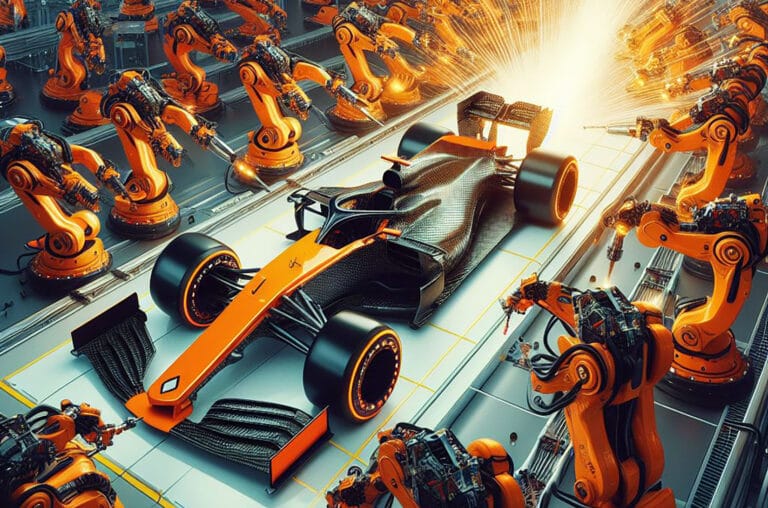Formula One race car technology has come a long way since the Grand Prix races of the 1920s and 30s—but data has always played a part.
Before high-performance computers and simulators generated terabytes of data to dictate designs, teams shaved down lap times by reducing weight and drag. (Fun fact: In 1934, removing paint to meet the weight limit revealed the silver bodywork of the car that earned the Silver Arrows’ its name.)
From Prototype to Podium
Today, F1 prototypes go through up to 25,000+ design changes a year, and every change is powered by rapid data analytics, simulations, modeling, and physics. The drivers may get the spotlight, but the cars they drive are possible thanks to the engineers, designers, and data scientists who craft them.
Every aspect of an F1 car, from its aerodynamics and downforce to its safety features, is based on data. The car designs go through rigorous testing, using state-of-the-art wind tunnels and simulators to perfect each element. This ensures that the prototype that hits the track is as close to flawless as possible.
Aerodynamics and Downforce: The Search for the Perfect Shape
When seconds, ounces, and inches are the difference between winning and losing, teams stake every decision on data—and leave nothing up to chance.
Aerodynamics is critical to the performance of an F1 car. This is where downforce comes into play. Downforce is the vertical force generated from the aerodynamics of the car, keeping it close to the ground for better control at high speeds.
To design a winning car, F1 teams use computational fluid dynamics (CFD) in wind tunnels to simulate the airflow around the car. Visible smoke markers predict airflow over the car’s bodywork, generating thousands of data points to construct a mathematical model of airflow over a defined surface.
Engineers inspect the routes air takes over and behind the car, analyzing the data to indicate where downforce is needed and can be optimized. This helps engineers shape the body of the car accordingly but requires use of a high-performance computing grid. Grid time, teraflops, and CPU power are tightly monitored by FIA rules, so data infrastructures need to be fast to make the most of each wind tunnel run. CFD simulation runs already create 7TB of data daily for the team and is expected to increase as regulations change.
Manufacturing Materials and Modular Parts
The various parts of an F1 car (referred to collectively as the kit) can be tested and swapped out to change the car’s performance and handling. This modularity is also helpful if there’s damage to the car during a race. The model of the car element(s) being tested in the wind tunnel can be output directly from the CAD software used by the team to get building.
Mesh testing is conducted on design pieces for durability and safety. The FEA method breaks the design piece into a mesh consisting of tiny triangles, which can then indicate the effect of external impacts on that mesh by calculating the force on each triangle. The results of these calculations help engineers see where elastic and plastic deformations may take place—essentially, where the chassis could fail under load.
It takes a high-tech team to pull this off. Material science engineers form hypotheses about composites, find new materials, run extensive R&D projects, and also spend time investigating failures from the track. Composite kit cutters produce the carbon fiber materials that are cut into molds to create parts for the car. These pre-cut sheets of carbon fiber are sent to the Comp Bond team and can include everything from the chassis to tiny brackets.
Building Safety into the Bodywork
Accidents will happen, but data plays an important role in keeping drivers safe. The mesh testing explained above can improve structural safety by learning how structures will respond to impact. But data has also led to entirely new components, such as the Halo cockpit protection system, created in 2018. The design process behind Halo involved the use of data from extensive testing, including simulated crashes and live tests, generating data that helped developers improve the structure and design of the device.
The Survival cell, or the monocoque, has been designed with data to ensure that the integrity of the structure is not compromised, remaining intact and protecting the driver from impacts, at all angles and speeds.
Furthermore, data is used to understand and analyze the forces that act on the human body during a crash. The FIA uses crash data and biometric sensors on drivers to ensure that safety features such as the seat, safety harness, and helmet provide the best possible protection.
Testing and Simulators
The design process for F1 cars is incredibly complex, with each part of the car having a direct impact on its performance. Testing and simulators play a vital role in the development of the car, helping drivers provide feedback on the car and get a feel for different tracks.
While wind tunnels simulate the car’s behavior in different weather conditions and track environments, simulators replicate the racing experience, giving teams the chance to test the car in a virtual environment. Tracks are precisely measured using LIDAR to detect every incline, bump, and irregularity for the most realistic experience possible. This makes the simulator a vital tool for F1 teams as it reduces the need for real-world testing on the physical car, saving significant costs and resources.
Simulation engineers develop the software and design of these programs, making algorithmic improvements and recreating events that happen on race weekends to find developmental directions that are delivered back to race engineers.
How F1s Team Iterates and Innovates
The design process of a winning Formula One race car is a perfect combination of technology, expertise, and data. Engineers and designers use cutting-edge computational tools and data to push the boundaries of physics, creating a highly optimized aerodynamic profile, while simulations and analytics provide valuable insights that can help create a car that is faster, safer, and more efficient.
It shows that Formula One is more than just sport and show—it’s a stunning example of humanity’s drive to innovate and progress. At Pure, this is something we definitely relate to.
![]()






